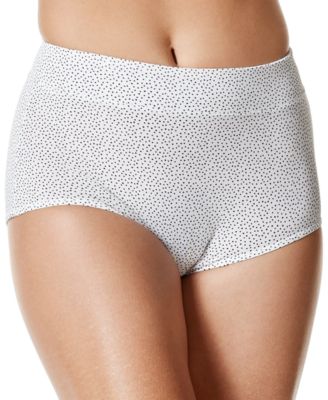The Most Fascinating Facts About Underwear

The Most Fascinating Facts About Panties. Have you ever wondered when panties were first invented? Let’s dive into the fascinating history of this essential undergarment and explore how supportive clothing, such as modern swimwear for various body types, has evolved over time.
In this article, you'll discover a collection of fun facts and underwear facts about panties and underwear, highlighting quirky, surprising, and entertaining tidbits from history and beyond.
Early Beginnings and the Middle Ages
Panties, also known as underpants or knickers, have been around for centuries. Some of the earliest forms of underwear were loincloths, which were basic pieces of clothing worn beneath or as outerwear in many ancient cultures.
The concept of covering one’s lower body dates back to ancient times, with both men and women using various garments for modesty and hygiene. Loincloths were often made from materials like linen or leather, depending on the civilization and available fabric. The ancient Egyptians, for example, wore linen loincloths called 'schenti', and King Tutankhamun was buried with over 100 pairs of underwear, highlighting the cultural significance and variations of their undergarments throughout history.
Evolution of Female Underwear and Panties
The modern concept of panties, as we know them today, began to take shape in the 19th century. During this time, women started wearing drawers, a type of loose-fitting undergarment that resembled shorts. These drawers were often made of soft cotton or linen for comfort.
As undergarments evolved, they became thinner and less bulky, providing a more comfortable fit.
During the same period, men's underwear styles such as boxer shorts, boxers, long johns, jockstraps, and jockey shorts were also evolving, with many designed to be worn at the waist for support and comfort.
Invention of Panties
The term “panties” itself is believed to have originated in the early 20th century. Around the same time, the bra was developed as an undergarment specifically designed to support and shape the breasts. As women’s fashion evolved, so did their undergarments, which were tailored to fit the wearer and provide support for the wearer's body, including the shoulders. Panties became more form fitting and tailored to the body, providing both support and coverage. Support garments like bras were frequently worn by women for comfort and to improve posture.
Popularization of Panties
By the mid-20th century, panties had become a staple in every woman’s wardrobe. Lingerie evolved into an essential and empowering part of a woman's wardrobe, contributing to confidence, femininity, and daily life. With the rise of synthetic fabrics like nylon and spandex, panties became more comfortable and durable. The growing trend to buy underwear in a variety of styles reflected personal expression, with the g string, originally a swimsuit style that gained popularity in South America, emerging as a fashionable choice in the 1990s. Different styles, such as briefs, bikinis, thongs, and g strings, emerged to cater to various preferences. 'Undies' became a fun and playful term for underwear, inspiring quirky trends and trivia that add a lighthearted touch to the world of lingerie.
Underwear Design and Technology
The world of underwear has come a long way since ancient times, with design and technology evolving to meet the ever-changing needs of wearers. In the earliest days, undergarments were crafted from natural fibers like cotton, linen, and wool, offering basic comfort and modesty. The Middle Ages saw underwear designed to be worn discreetly beneath outer garments such as pants and dresses, with a focus on both function and form.
A major turning point in underwear history was the invention of the elastic waistband in the 19th century. This simple yet revolutionary feature transformed underwear, making it more comfortable and adaptable to the wearer’s body. Suddenly, briefs, boxer briefs, and thongs could offer a snug, flexible fit that moved with the body, setting the stage for the modern styles we know today.
In the present day, underwear design is all about combining comfort, support, and style. Innovative fabrics like breathable mesh and moisture wicking materials keep the skin cool and dry, while advanced manufacturing techniques, think 3D knitting and laser cutting, allow for seamless, form-fitting designs. Whether you’re slipping into a pair of boxer briefs for everyday wear or choosing a lacy thong for a special occasion, today’s underwear is engineered for both performance and fashion.
Celebrity underwear trends have also left their mark on the industry. The rise of boxer briefs, popularized by stars like David Beckham and Justin Bieber, has made this style a staple in men’s underwear drawers. On the women’s side, icons such as Kim Kardashian and Beyoncé have influenced the design and marketing of female underwear, putting the spotlight on comfort, support, and body positivity. Red underwear, often seen on celebrities and influencers, has become a bold fashion statement, symbolizing everything from good luck to romance, depending on the culture.
The Chicago Sporting Goods Company has played a pivotal role in underwear innovation, especially in the world of sports. Their invention of the jockstrap provided essential support for athletes, and their ongoing commitment to new materials and designs continues to shape the future of athletic underwear.
Women’s health has also benefited from advances in underwear technology. Modern bras and panties are designed with breathable fabrics, adjustable straps, and moisture wicking properties to ensure maximum comfort and support throughout the day.
Conclusion
In conclusion, panties have a long and storied history, evolving from simple coverings to stylish and functional undergarments. While the exact date of their invention may be unclear, one thing is certain: panties have become an essential part of daily attire for people around the world.
Check out our homepage Olivia Paisley or review our Terms of Service


